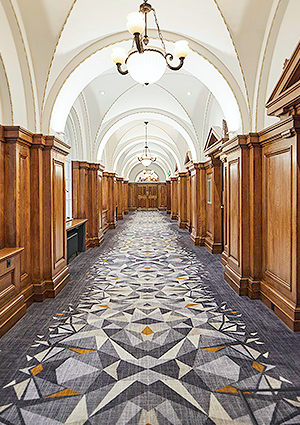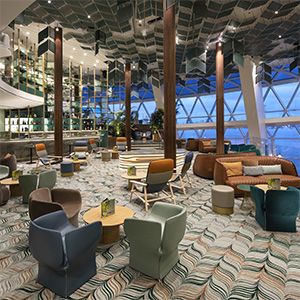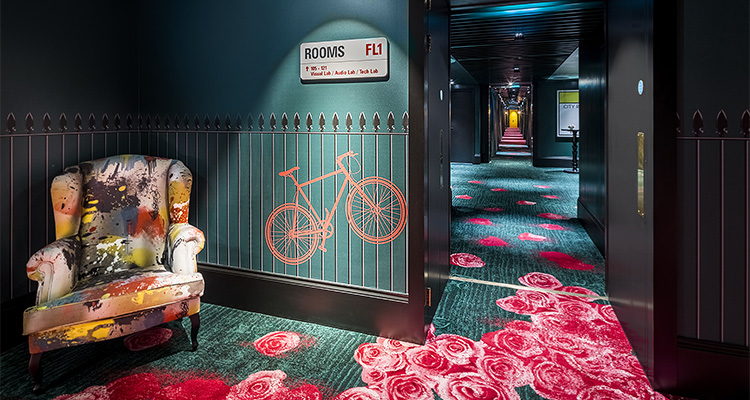Building on an impressive heritage, Brintons is weaving a legacy of luxury, quality, and innovation
Founded in 1783, Brintons is a renowned British manufacturer of woven carpets and up until 2008, stood as a pillar of the historic carpet manufacturing center of Kidderminster. Promising to deliver unparalleled quality and craftsmanship, Brintons prides itself on bringing spaces to life with striking patterns and bespoke creations, whether for a luxury hotel, casino, cruise ship, or a residential setting.
Until 2011, the business was owned by the Brinton family since William Brinton set it up in the late 1700s. However, facing the hardship of the 2008 financial crash, the family decided to sell. As a result, a private equity firm took over operations with a view to restructuring the business to secure its long-term future.
Throughout the changes to ownership, there have also been impressive technological advancements in the carpet manufacturing space; add to that a global pandemic and unprecedented inflation, and it’s clear that Brintons is an agile company with a heritage and combined expertise that ensures its success. In 2014, Duccio Baldi was headhunted to take over as the new CEO of Brintons with the aim to modernize the business and propel it towards another generation of success.
pandemic and unprecedented inflation, and it’s clear that Brintons is an agile company with a heritage and combined expertise that ensures its success. In 2014, Duccio Baldi was headhunted to take over as the new CEO of Brintons with the aim to modernize the business and propel it towards another generation of success.
We sit down with Duccio on the cusp of his tenth anniversary with Brintons to discuss the company’s history and how it has navigated vast changes over the last 200 years. “There has certainly been a lot of change, as the business has grown from making pieces of carpet in the 18th century to fitted wall-to-wall carpets today,” Duccio opens. “In the 19th century, carpets were expensive and considered a luxury decorative item used not only on floors, but also to decorate walls. Arguably the biggest change in the history of the carpet industry came because of the Industrial Revolution as the technology behind the process developed.
“In the 1950s, there was a huge regeneration of engineering across post-war Europe, which resulted in more efficient, faster processes for several industries. However, although technology has progressed, the construction of a woven or Axminster carpet is much the same today as when it was first invented using looms. People would move the thread or yarn back and forth across the loom, and the concept still applies today ; it’s just that the process has now become mechanical and electronic, meaning carpets can be produced more efficiently and in far greater quantities.
“We specialize in woven carpets and rugs,” Duccio clarifies. “The woven nature of the carpet makes it reliable, durable, and long lasting, as the tufts are sewn to the backing, rather than glued like tufted carpet. For this reason, woven carpet is typically more expensive, as the weaving process takes more time, but in return, the carpet is stronger and more hardwearing. Our woven carpets are often found in some of the world’s most luxurious hotels, cruise ships, and casinos.
“The other area that has been transformed by technological developments is our design process. Historically, all carpet designs were hand drawn and then produced by changing colors on the loom, but computer technology enables artists to create designs directly on screen, which can then more easily be configured to our modern looms. Carpet designers still require an artistic background, and although some designers still sketch out an early design by hand, innovative technology streamlines the final process.”
With a tagline to ‘make the world a more beautiful place,’ it’s clear that Brintons prioritizes quality products that are unmatched by competitors. “Our single largest market is hospitality, which encompasses hotels, casinos, cruise ships, and convention centers, all of which are at the top end of the scale in terms of luxury,” Duccio explains. “These customers typically choose an Axminster type carpet because they do not want to be constrained on design, as we can weave almost any pattern. Axminster carpet gives us a degree of flexibility to create curves or seamless designs for large spaces.
“A traditional loom can weave up to 12 or 16 colors, but in the early 2000s, we introduced revolutionary technology that enabled us to change the head of a loom to weave up to 32 colors. We increased our color selection not only to provide greater color choice, but also because high-definition carpet provides the option for graduation. This means customers can choose a particular color, and we then create a graduated design with several shades of the color, which is particularly popular among customers with large areas to cover.
 “High coloration tends to be used in very prestige jobs, where budgets are less constrained and the customer is willing to pay for design innovation,” he continues. “These designs aren’t typically found in residential settings, but instead in luxury spaces. In casinos, for example, the carpet is specifically designed to be vibrant, and ultimately, to keep customers at the tables!
“High coloration tends to be used in very prestige jobs, where budgets are less constrained and the customer is willing to pay for design innovation,” he continues. “These designs aren’t typically found in residential settings, but instead in luxury spaces. In casinos, for example, the carpet is specifically designed to be vibrant, and ultimately, to keep customers at the tables!
“Not only did the high-definition technology enable us to increase the number of colors, but it also increased the loom’s efficiency by reducing the time it takes to change the loom from one project to another. The changeover process previously required our staff to feed and change 1104 bobbins per color in a process that took around 40 hours to complete. In comparison, the new loom uses far fewer packages, dramatically reducing the changeover time to around 30 minutes.”
In 2015, Brintons acquired the rug and carpet manufacturer Agnella, based in northeastern Poland. This afforded Brintons the opportunity to consolidate its manufacturing base and to relocate production. With escalating manufacturing costs in the UK, in hindsight, this turned out to be a critical decision in helping the company through the last few tumultuous years of the pandemic and the war in Ukraine. “We operate a plant in India, which serves the Far East, Middle East and the US, and we have two plants in Europe, in Poland and Portugal, to serve Europe and the US,” Duccio reveals. “We own all our manufacturing facilities and strive to ensure they have the same operating levels when it comes to quality, efficiency, and health and safety standards. Our products can be manufactured with the same high standard from any plant and during the past five years, we have supplied carpet to around 150 countries.”
Priding itself on quality, Brintons operates with strict manufacturing standards and guidelines around sourcing. “The single largest constituent part of a woven carpet is wool,” Duccio states. “In the 1950s, we developed an 80/20 mix – 80 percent wool and 20 percent nylon – which quickly became the industry standard, offering a yarn that is not only easier to weave, but also more durable. At Brintons, we use British wool in our production facilities, which is sourced in the UK and consolidated in the North of England, where it is cleaned and blended to our proprietary formula prior to shipping.
“More recently, we have created a sustainable alternative carpet, which is completely plastic free and made from natural products including 100 per cent wool, cotton, and jute. As a biodegradable product, it’s working well with customers in residential and we are trialing it in selective commercial spaces, particularly as we see increasing demand for environmentally friendly products from our customers.
“We have also acquired technology that will enable us to manufacture Axminster carpet tiles, including critical match tiles, which would allow customers to lay tiles within a pattern match of two millimeters. We’ve invested in the appropriate technology to enhance our capabilities, as carpet tiles are particularly popular in casino settings.”
As our conversation draws to a close, Duccio reflects on the last few years in business and shares how these experiences will shape the organization moving forward. “It’s been a challenging few years in the industry, especially as the Covid-19 pandemic impacted the hospitality market and as a result, people weren’t traveling,” he says. “However, we had a steady stream of mid-size hotel refurbishments throughout the pandemic, and we’re starting to see large projects return to our books as the market recovers.
“For example, we’ve just received a $2.3 million order for the Gaylord Pacific Resort and Convention Center in San Diego,” Duccio concludes. “This year, we expect to be just shy of our pre-Covid turnover, but we anticipate full market recovery to flush out the ‘Covid effect’ within the next year. This has been evidenced by the return of refurbishment work in the cruise sector, which is expected to experience continuous growth in coming years.”
Throughout its history, Brintons has survived industry changes and come out on top. With Duccio at the helm, the business is sure to deliver excellence as it continues to develop new specialist products at the forefront of the luxury carpet market.
